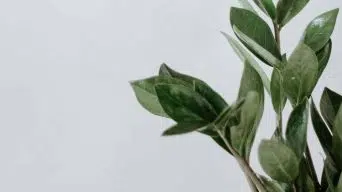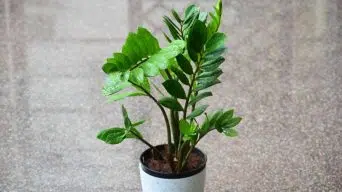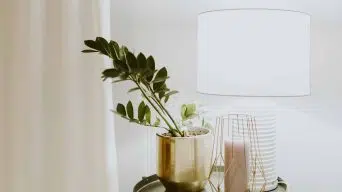Improper watering is the most common cause of ZZ plant leaves falling off. Underwatering or overwatering can both cause leaves to drop. To avoid this, follow a consistent watering schedule. Water the plant when the top inch of soil is dry, and water deeply until liquid comes out of the drainage holes on the pot.
Zamioculcas zamiifolia, ZZ plants, are known for being tough, low-maintenance houseplants. They can thrive in a wide range of lighting conditions and don’t need much water.
However, even the hardiest of plants can experience problems from time to time.
One common issue that ZZ plant owners face is leaves falling off the plant.
There are a few reasons why this might happen, and luckily, you can also do a few things to fix the problem.
This article will explore why ZZ plant leaves might fall off and how to solve the issue.
What Causes ZZ Plant Leaves to Fall Off?
A few reasons might cause ZZ plant leaves to fall off.
You need to closely examine your plant to determine which one is affecting your Zamioculcas zamiifolia, so you can take the appropriate action to fix the problem.
The most common reasons for ZZ plant leaves falling off are:
Overwatering
Overwatering is one of the most common problems that houseplants face. When a plant is overwatered, the roots can’t get the oxygen they need to survive.
Also, the waterlogged roots cannot absorb nutrients from the soil, which causes yellow leaves to fall off eventually.
If you think your ZZ plant is being overwatered, check the soil. If it feels soggy or wet, you probably gave it too much water.
Let the soil dry out completely before watering your plant again. You can also move your plant to a pot with better drainage.
Underwatering
Underwatering is another common reason for ZZ plant leaves to fall off. When a plant doesn’t get enough water, the leaves turn brown and crispy and eventually fall off because the plant cannot absorb the water it needs from the soil.
If you think your plant is underwater, check the soil. If it feels dry or dusty, you must water it.
Be sure to give your plant a good soaking so the water can reach the roots. You may need to water your plant more frequently during the hot summer.
Extreme Temperatures
Extreme temperatures can also cause ZZ plant leaves to fall off. The leaves will turn brown and drop off if the temperature is too hot or too cold.
To prevent this from happening, ensure your plant is in a room between 65-85 degrees Fahrenheit.
If the temperature in your home fluctuates often, you can move your plant to a more stable environment, such as an office or a greenhouse.
Not Enough Light
ZZ plants need bright, indirect light to thrive. If they don’t get enough light, their leaves will turn yellow and eventually fall off.
Light is essential for photosynthesis, which is how plants make their food.
If your ZZ plant isn’t getting enough light, move it to a brighter location.
You can also add a grow light to give your plant the extra light it needs.
Too Much Sunlight
Too much sunlight can also cause ZZ plant leaves to fall off. If the leaves are exposed to direct sunlight, they will turn brown and fall off.
To prevent this, ensure your plant is in a location with bright, indirect light.
You can also move your plant to a different location or adjust the blinds to filter the light.
East—or west-facing windows are usually the best spots for ZZ plants, as they provide bright indirect light.
Soil Issues
Too dense or sandy soil can cause ZZ plant leaves to fall off. If the soil doesn’t have the right texture, it can’t hold onto water and nutrients, which causes the ZZ plant leaves to turn yellow and start falling off.
To fix this problem, you need to choose a well-draining potting mix with sand, peat moss, and perlite.
You can also add some organic matter, such as compost or manure, to improve the drainage and texture of the soil.
Pests
Pests can also cause ZZ plant leaves to fall off. The leaves will eventually fall off if your plant is infested with pests.
The most common pests that attack ZZ plants are mealybugs, spider mites, and aphids.
Mealybugs are tiny white insects that feed on the sap of plants. They can cause yellowing leaves.
Spider mites are tiny red or black insects that spin webs on plant leaves. They can cause the leaves to turn brown and eventually fall off.
Aphids are tiny green or black insects that suck the sap from plants. They can cause leaf drop.
You can use insecticidal soap or neem oil to get rid of pests. You can also wipe the leaves with a damp cloth to remove the pests.
Diseases
Diseases can also cause ZZ plant leaves to fall off. The leaves may start dropping if your plant is infected with an illness.
The most common diseases that affect ZZ plants are root rot and leaf spot.
Root rot is caused by too much water, which can cause the roots to rot.
Leaf spot is caused by fungi or bacteria that attack the leaves of plants causing brown leaves to fall off eventually.
To prevent diseases, you must water your plant correctly and avoid overwatering. You should also make sure your plant has enough light and air circulation.
Fertilizer Issues
Too much or too little fertilizer can also cause ZZ plant leaves to fall off. The leaves may start falling off if the plant gets too much fertilizer.
If the plant is not getting enough fertilizer, it will lose its color, and the leaves will fall off.
To fix this problem, you must fertilize your plant once a month during the growing season. Avoid fertilizing during the winter, as this can damage the plant.
Chemical Damage
Chemicals can also cause ZZ plant leaves to fall off. If the leaves come into contact with chemicals, they will turn brown and fall off.
To prevent this, you need to keep your plant away from chemicals, including cleaning products, pesticides, and herbicides.
You should also avoid using chemical fertilizers, which can damage the plant.
Transplant Shock
Transplant shock can also cause ZZ plant leaves to fall off. This happens when a plant is moved to a new location and doesn’t have time to adjust, causing yellow leaves that eventually will drop off.
To prevent transplant shock, your plant must be acclimated to its new location. This means slowly moving it over some time.
You should also ensure the plant has enough light and water in its new location.
Natural Leaf Drop
Natural shedding can also cause ZZ plant leaves to fall off. The plant sheds its older leaves to make room for new growth.
Natural shedding is normal and nothing to worry about. However, if the plant is shedding too many leaves, it could be a sign of a problem.
If you think your plant is shedding too many leaves, you should check for pests, diseases, and other problems.
What To Do When ZZ Plant Leaves Fall Off
If you notice that your plant’s leaves are starting to fall off, you can do a few things to help.
Check for Pests
One of the most common reasons for leaves falling off is pests.
If you see any small insects on the plant or if the leaves have strange markings, pests are likely to blame.
Small insects can be challenging to spot, so it’s also a good idea to check the underside of the leaves. If you see any insects, you can remove them by hand or use insecticide soap or neem oil.
Check for Diseases
Diseases can also cause leaves to fall off. If you see any spots, wilting, or discoloration on the leaves, checking for diseases’s a good idea.
A few common diseases affect ZZ plants, such as leaf spot and root rot. If you think your plant has a disease, remove any affected leaves and dispose of them. You can also use a fungicide to treat the plant.
Check Your Watering Schedule
If you water your plant too much or too little, the leaves can fall off.
Overwatering can cause the roots to rot, leading to leaf falloff. If you think you’re overwatering your plant, check the soil before watering it. The top inch of soil should be dry before you water the plant again.
Underwatering can also cause leaves to fall off. If the leaves are dry and crispy, it’s a sign that the plant isn’t getting enough water. Try giving your plant a good drink of water and see if that helps.
ZZ plants need to be watered about once a week or when the top inch of the soil is dry.
Check Your Light Levels
If your plant receives too much or too little light, the leaves can fall off.
Too much light can scorch the leaves, while too little light can cause the ZZ plant to become leggy and weak.
If your plant isn’t getting enough light, try moving it to a brighter spot.
If the leaves look yellow or pale, it’s a sign that the plant is getting too much light. Try moving it to a spot that gets indirect sunlight.
Avoid putting your plant in direct sunlight, which can scorch the leaves.
Check for Nutrient Deficiencies
A nutrient deficiency can also cause leaves to fall off. The most common nutrient deficiency is a lack of nitrogen. This can cause the leaves to turn yellow and eventually fall off.
If you think your plant has a nutrient deficiency, consider using a nitrogen fertilizer. You can also add compost or manure to the soil to help improve the plant’s nutrition.
Check the Temperature
If the temperature is too hot or too cold, it can cause the leaves to fall off.
ZZ plants prefer warm temperatures between 65 and 85 degrees Fahrenheit. If the temperature gets too hot or too cold, it can stress the plant and cause the leaves to fall off.
You can try moving your plant to a warmer or cooler spot to see if that helps. You can also use a humidifier or fan to help regulate the temperature.
Prune the Plant
Pruning can also help if your plant’s leaves are falling off. If the plant is leggy or overgrown, pruning it back will help encourage new growth.
You can remove any yellow or brown leaves and stems longer than a few inches. Try to prune the plant back by a third to help it recover.
Repot the Plant
It’s a good idea to repot your plant every year or two. This will help the plant get the nutrients it needs and aerate the roots.
If you think your plant needs to be repotted, choose a pot one size larger than the current pot. Use fresh potting soil and wait until the plant has had time to adjust before watering it.
Repotting can also help if your ZZ plant is root-bound. This means the roots have filled up the pot and are crowded. In this case, you’ll need to repot the plant into a larger pot.
What Are The Benefits Of ZZ Plant Leaves Falling Off?
A few benefits to having your ZZ plant’s leaves fall off.
- It allows the plant to focus its energy on new growth.
- It helps the plant eliminate old leaves without enough light or nutrients.
- It helps the plant conserve water by preventing evaporation from the leaves.
- It can help the plant resist pests and diseases.
The benefits of having your ZZ plant’s leaves fall off outweigh the negatives.
If you think your ZZ plant is healthy and just shedding its leaves as part of its natural growth cycle, there’s no need to worry.
What To Do With ZZ Plant Leaves That Have Fallen Off?
You can do a few things with the leaves that have fallen off your ZZ plant.
- You can add them to your compost pile.
- You can use them as mulch around other plants.
- You can dry them and use them as decorations.
Or, you can throw them away. Ultimately, it’s up to you what you do with the leaves. If you think they’ll be of use, go ahead and add them to your compost or use them as mulch. Otherwise, there’s no need to keep them around.
Final Thoughts
ZZ plant care is pretty simple. However, leaves dropping off is a common issue that plant owners face.
If your ZZ plant’s leaves are falling off, it’s likely due to one of the reasons we covered in this article.
By taking a closer look at your plant and implementing some of the suggested solutions, you should be able to get your ZZ plant back on track quickly!







